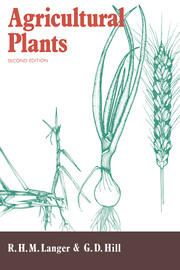Book contents
- Frontmatter
- Contents
- Preface to the first edition
- Preface to the second edition
- 1 World population and crop production
- 2 Plant structure
- 3 Liliaceae
- 4 Poaceae
- 5 Apiaceae
- 6 Asteraceae
- 7 Brassicaceae
- 8 Cannabinaceae
- 9 Chenopodiaceae
- 10 Cucurbitaceae
- 11 Fabaceae
- 12 Lamiaceae
- 13 Linaceae
- 14 Malvaceae
- 15 Papaveraceae
- 16 Solanaceae
- 17 Physiological basis of yield
- Index of specific names
- Subject index
10 - Cucurbitaceae
Published online by Cambridge University Press: 05 June 2012
- Frontmatter
- Contents
- Preface to the first edition
- Preface to the second edition
- 1 World population and crop production
- 2 Plant structure
- 3 Liliaceae
- 4 Poaceae
- 5 Apiaceae
- 6 Asteraceae
- 7 Brassicaceae
- 8 Cannabinaceae
- 9 Chenopodiaceae
- 10 Cucurbitaceae
- 11 Fabaceae
- 12 Lamiaceae
- 13 Linaceae
- 14 Malvaceae
- 15 Papaveraceae
- 16 Solanaceae
- 17 Physiological basis of yield
- Index of specific names
- Subject index
Summary
This family which comprises some 90 genera and 750 species is of wide geographic origin. Cultivated cucurbits are thought to have arisen in the Western Hemisphere, Africa, and Asia. Cucurbits are usually grown for their fruits which are large and are eaten fresh in salads or as a dessert. They are pickled and cooked and served as vegetables. Certain species commonly called pumpkins develop a very hard exocarp which allows them to be stored for considerable periods of time, thus providing an important source of winter vegetables in some countries. The hard exocarp can also be used in the production of gourds which are ornamented and used for storage and for carriage of liquids in many primitive cultures. One species, the loofah, is eaten in Asia but in Europe the fibrous vascular system of the fruit is retained and is put to a variety of uses ranging from a substitute for bath sponges to niters in industrial engines. In other cultures the seeds of cucurbits are dried and salted and are eaten in much the same way as peanuts or potato crisps. In the tropics the spreading tangled vines of Momordica charantica, besides providing food, are utilised as a cover crop in plantations.
General morphology
All cucurbits tend to be frost-tender although, as a result of the work of plant breeders, most cultivated species have now spread well into temperate environments in the summer time. Cultivated cucurbits are usually annuals which rapidly produce a dense vegetative cover.
- Type
- Chapter
- Information
- Agricultural Plants , pp. 209 - 216Publisher: Cambridge University PressPrint publication year: 1991

